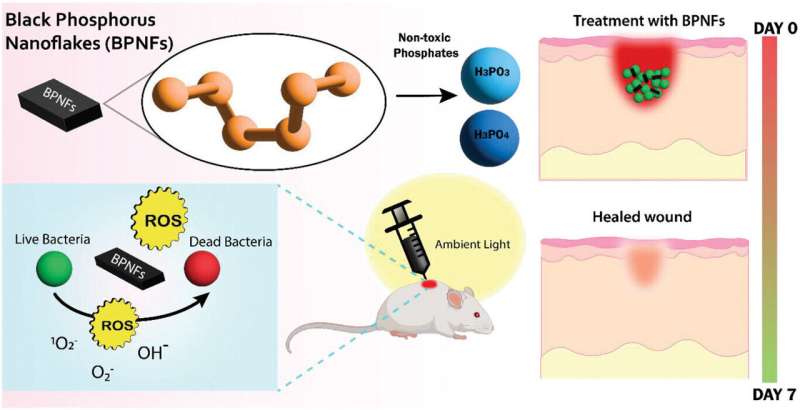
Researchers have invented a nano-thin superbug-slaying material that could one day be integrated into wound dressings and implants to prevent or heal bacterial infections.
The innovation—which has undergone advanced pre-clinical trials—is effective against a broad range of drug-resistant bacterial cells, including “golden staph,” which are commonly referred to as superbugs.
Antibiotic resistance is a major global health threat, causing about 700,000 deaths annually, a figure which could rise to 10 million deaths a year by 2050 without the development of new antibacterial therapies.
The new study led by RMIT University and the University of South Australia (UniSA) tested black phosphorus-based nanotechnology as an advanced infection treatment and wound healing therapeutic.
Results published in Advanced Therapeutics show it effectively treated infections, killing over 99% of bacteria, without damaging other cells in biological models.
The treatment achieved comparable results to an antibiotic in eliminating infection and accelerated healing, with wounds closing by 80% over seven days.
The superbug-killing nanotechnology developed internationally by RMIT was rigorously tested in pre-clinical trials by wound-healing experts at UniSA. RMIT has sought patent protection for the black phosphorus flakes including its use in wound healing formulations, including gels.
RMIT co-lead researcher, Professor Sumeet Walia, said the study showed how their innovation provided rapid antimicrobial action, then self-decomposed after the threat of infection had been eliminated.
“The beauty of our innovation is that it is not simply a coating—it can actually be integrated into common materials that devices are made of, as well as plastic and gels, to make them antimicrobial,” said Walia from RMIT’s School of Engineering.
A previous study led by RMIT revealed that black phosphorus was effective at killing microbes when spread in nano-thin layers on surfaces used to make wound dressings and implants such as cotton and titanium, or integrated into plastics used in medical instruments.
How the invention works
Black phosphorus is the most stable form of phosphorus—a mineral that is naturally present in many foods—and, in an ultra-thin form, degrades easily with oxygen, making it ideal for killing microbes.
“As the nanomaterial breaks down, its surface reacts with the atmosphere to produce what are called reactive oxygen species. These species ultimately help by ripping bacterial cells apart,” Walia said.
The new study tested the effectiveness of nano-thin flakes of black phosphorus against five common bacteria strains, including E. coli and drug-resistant golden staph.
“Our antimicrobial nanotechnology rapidly destroyed more than 99% of bacterial cells—significantly more than common treatments used to treat infections today.”
The global war on superbugs
Co-lead researcher Dr. Aaron Elbourne from RMIT said health care professionals around the world were in desperate need of new treatments to overcome the problem of antibiotic resistance.
“Superbugs—the pathogens that are resistant to antibiotics—are responsible for massive health burdens and as drug resistance grows, our ability to treat these infections becomes increasingly challenging,” Elbourne, a Senior Research Fellow in RMIT’s School of Science at RMIT, said.
“If we can make our invention a commercial reality in the clinical setting, these superbugs globally wouldn’t know what hit them.”
Treatment efficacy in preclinical models of wound infection
Lead researcher from UniSA, Dr. Zlatko Kopecki, and his team performed the pre-clinical trials to show how daily topical application of the black phosphorus nanoflakes significantly reduced infection.
“This is exciting as the treatment was comparable to the ciprofloxacin antibiotic in eradicating wound infection and resulted in accelerated healing, with wounds closing by 80% over seven days,” Dr. Kopecki said.
Dr. Kopecki, who is also a Channel 7 Children’s Research Foundation Fellow in Childhood Wound Infections, said antibiotic treatments are becoming scarce.
“We urgently need to develop new alternative non-antibiotic approaches to treat and manage wound infection,” he said.
“Black phosphorus seems to have hit the spot and we look forward to seeing the translation of this research towards clinical treatment of chronic wounds.”
The team wants to collaborate with potential industry partners to develop and prototype the technology.
More information:
Emmeline P. Virgo et al, Layered Black Phosphorus Nanoflakes Reduce Bacterial Burden and Enhance Healing of Murine Infected Wounds, Advanced Therapeutics (2023). DOI: 10.1002/adtp.202300235
Provided by
RMIT University

READ MORE
Research team discovers more than 50 potentially new deep-sea species in one of the most unexplored areas of the planet
A Chaunax documented on the southwestern flank of Rapa NuiA Chaunax (genus of bony fish [...]
Best electric toothbrushes 2024 for clean teeth and gums
Brighten your smile with the best electric toothbrushes: Tested and ranked, with full reviews covering [...]
Thomas Edison vs. Nikola Tesla Quiz
Polynesians Beat Europeans to the “New World”
For decades, scientists have debated how the chicken crossed the ocean. Now, a new analysis [...]
Before Seeing ‘Turning Red,’ Learn These Amazing Red Panda Facts
Red pandas are classified as endangered and are legally protected in their home countries. aaronchengtp [...]
Caring for Komodo Dragons, the World’s Largest Lizards
Reptile keepers are warming up to a new monitor lizard this winter, a young Komodo [...]
What Makes a ‘Killer’ Lake Explode?
Rwanda’s Lake Kivu is considered a “killer” lake because of the huge amounts of biogas [...]
How California’s Giant Sequoias Tell the Story of Americans’ Conflicted Relationship With Nature
/ A stand of giant sequoias at Sequoia National Park in California. Library of Congress [...]